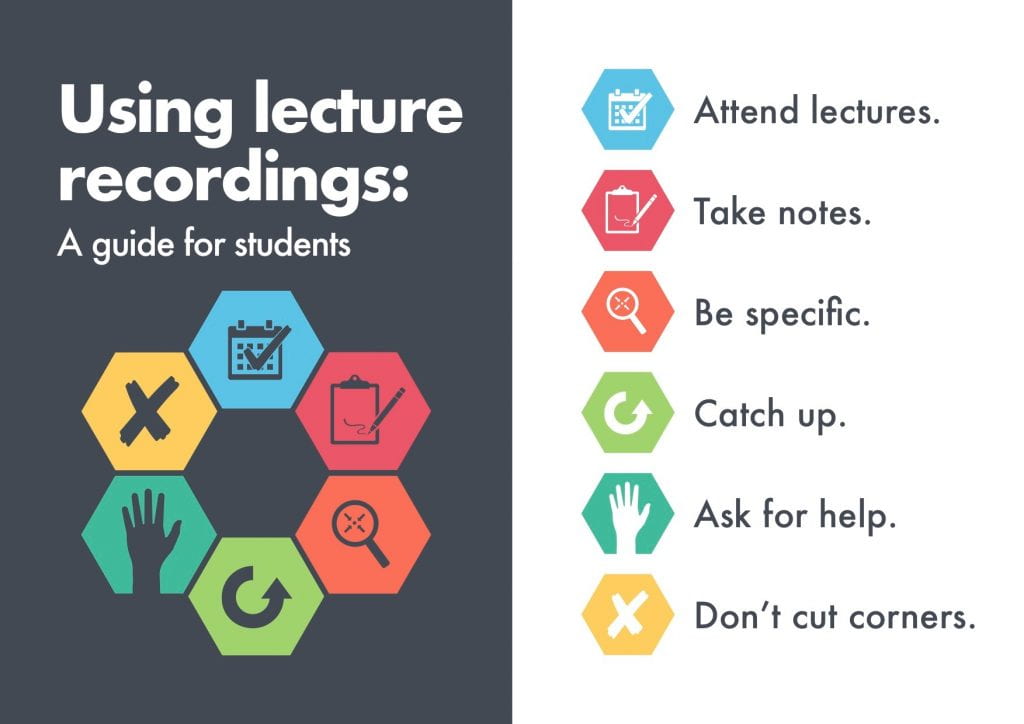On 30 October 2019, Dr Emily Nordmann gave a webinar on lecture capture presenting current research, important factors to consider, and practical recommendations for lecturers and students in Higher Education. Lecture capture or lecture recordings is a much-discussed topic in Higher Education – students welcome and request it and faculty are, in general, less enthusiastic about it. Independent of the different views people may have on lecture recordings, it is something that will eventually reach all Higher Education institutions in the future. So, we better get ready now and make sure to prepare teaching staff and students as well as possible because lecture capture has the potential to enrich the learning environment – if used correctly.
First of all, it seems important that teaching staff overcome the most common fear associated with lecture recordings, namely that attendance in class will drop. Emily reviewed many research papers on lecture capture and attendance and concludes that there is no systematic relationship between the availability of lecture recordings and attendance. More specifically, there seem to be important moderators, such as the quality of teaching, time of day, and interest in topic, that need to be taken into consideration and that can explain attendance in live lectures better than lecture recordings alone.
More importantly for student learning: The way lecture recordings are used is much more reflective of student performance in the course. Students who use the recordings as supplement instead of substitute to attending the lectures perform better than students who only attend lectures or only watch the recordings. Thus, this speaks for a general enrichment of the learning experience when lecture recordings are made available to students and when they are informed how to use them, namely. Strikingly, the group of students that benefits most from lecture recordings are non-native speakers or students with mental health issues. Thus, lecture capture provides an inclusive learning environment for students.
Emily presented brand-new data looking into general use of lecture recordings by students versus strategic use of lecture recordings by students. It is a good idea to make the distinction between use and strategic use. For example, students could be binge-watching lecture recordings (check for usage), but from memory research we know that cramming is ineffective for long-term retention of the material. Instead using the recording to clarify points that they did not fully understand during the live lecture (check strategic usage) would be a more effective way to engage with the recording. Emily presented data showing that 1) students tend to use the lecture recordings less strategically and 2) there seems to be no relationship between usage of recordings and how well they use the recordings. Further, students who made more use of lecture recordings were less inclined to seek help by asking the lecturer or other people. This could have important practical implications and may point to the recommendation that students should be encouraged to seek help – even if there are lecture recordings available.
The take-home-message from this webinar is that lecture recordings have the potential to enrich the student experience and this is particularly the case for students who can benefit from the additional support that lecture recordings offer, students who are non-native speakers or students who are dealing with mental health issues. However, simply uploading the recordings and hope for the best will not be enough. Students (and staff) need guidance on how to use lecture recordings optimally. We, Emily Nordmann, Carolina Kuepper-Tetzel, Louise Robson, Stuart Phillipson, Gabi Lipan, and Peter McGeorge, have written a review paper on “Lecture capture: Practical recommendations for students and instructors” which is currently under review, but uploaded a previous version of the paper as pre-print here: https://psyarxiv.com/sd7u4. In this paper we review the current lecture capture research and provide hands-on tips for students and staff. Feel free to browse it. It comes with useful and illustrative study guides.
About Dr Emily Nordmann:
 Dr Emily Nordmann is a teaching-focused lecturer in the School of Psychology, University of Glasgow. The main focus of her pedagogical research is how lecture capture can be used as an effective learning tool. She teaches statistics and research methods using R and is a firm supporter of open and reproducible research practices and educational resources. You can follow her on Twitter @EmilyNordmann.
Dr Emily Nordmann is a teaching-focused lecturer in the School of Psychology, University of Glasgow. The main focus of her pedagogical research is how lecture capture can be used as an effective learning tool. She teaches statistics and research methods using R and is a firm supporter of open and reproducible research practices and educational resources. You can follow her on Twitter @EmilyNordmann.
Supporting material:



Recent Comments